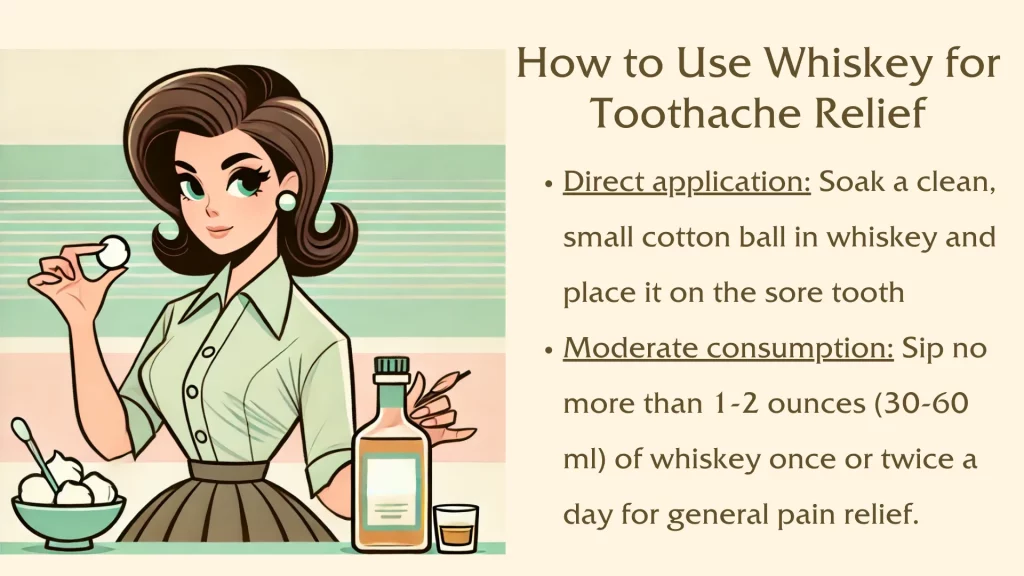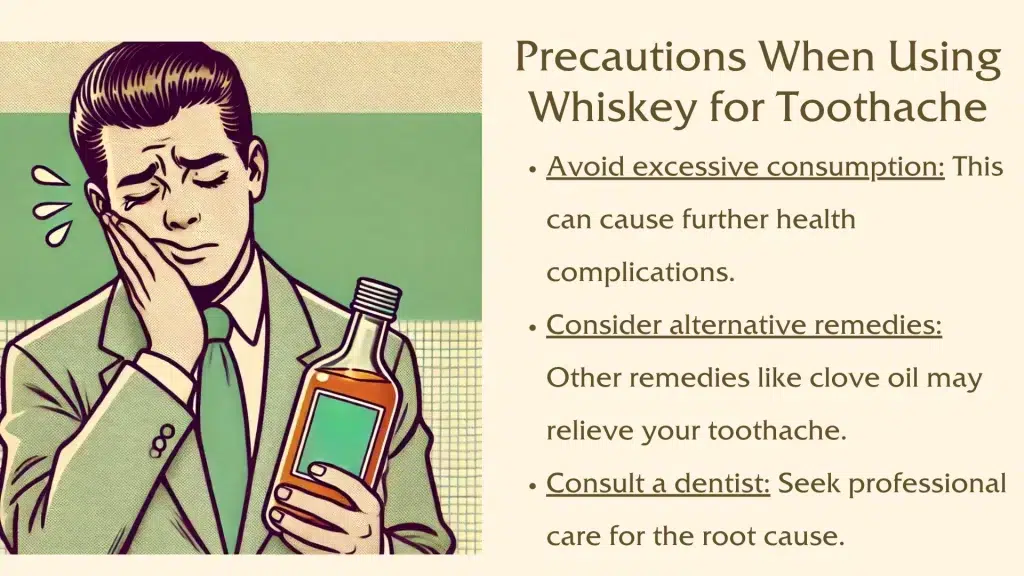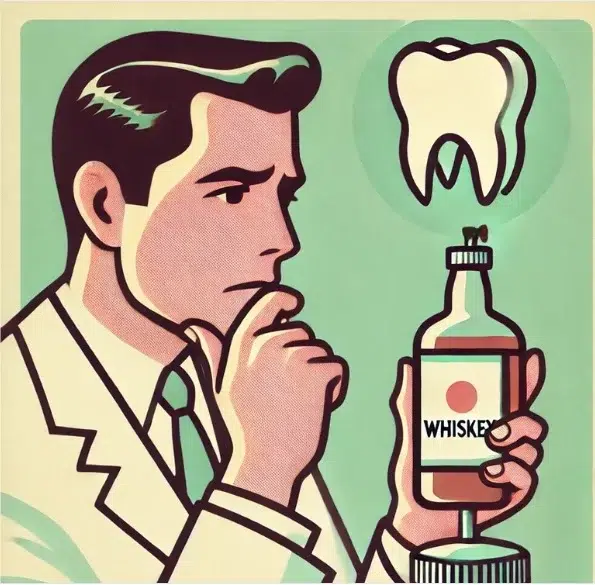Toothaches can be a miserable experience, leaving you searching for quick and effective relief. It’s usually caused by underlying issues that need professional dental care such as decay or gum disease – but in the meantime, you may want a home remedy for quick relief. One popular home remedy for toothache is a swish of whiskey. But does it actually help?
Let’s explore how whiskey may provide temporary relief, the science behind its effects, and how to use it safely as a short-term solution alongside professional dental care.
How Can Whiskey Help with Toothaches?
Whiskey’s ability to ease toothache pain lies in its analgesic and antiseptic properties. These qualities can temporarily numb discomfort and reduce the risk of infection, providing short-term relief. However, whiskey only addresses the symptoms and not the root cause of the toothache, making it crucial to seek proper dental treatment.
Analgesic Properties Reduce Pain
Whiskey’s alcohol content acts as a natural numbing agent. When applied directly to the affected area, whiskey can desensitize nerve endings, dulling sharp pain. This effect occurs because alcohol temporarily reduces the sensitivity of pain receptors, providing localized relief from dental discomfort.
Note that the efficacy of whiskey to reduce local tooth pain varies from person to person. If the pain persists, it’s best to see your dentist to get to the bottom of it.
Antiseptic Qualities Prevent Infection
Ethanol, the active ingredient in whiskey, has antimicrobial properties that can kill bacteria in the oral cavity. This helps to disinfect the area around an aching tooth, reducing the risk of infection and preventing existing issues from worsening.
Types of Whiskey Suitable for Toothache Relief
When using whiskey to ease a toothache, not all types are equally effective. High-alcohol-content whiskeys may be more efficient at numbing pain and potentially disinfecting the area.
Scotch in particular has a distinct distillation process and ingredients that may avoid irritating your tooth. However, you may prefer using bourbon instead because it’s known for its smoothness and sweet undertones, making it more palatable for direct application.
Choose either of the two depending on which quality is most important to you. One thing’s for sure though: flavored whiskeys or those with added sugars should be avoided. These products often have lower alcohol content and additives that could irritate the tooth or gums rather than provide relief.
How to Use Whiskey for Toothache Relief
Whiskey can be applied directly to the affected area or consumed in moderation to help ease toothache pain. Here’s a guide to using it effectively and safely:

Direct Application on the Affected Tooth
By soaking a clean, small cotton ball or swab in whiskey and placing it onto the sore tooth and adjacent gums, the alcohol serves as a local anesthetic, quickly numbing the area. Try this method for targeted, immediate relief:
- Soak a Cotton Ball: Use a small, clean cotton ball or swab and soak it in whiskey.
- Apply to the Tooth and Gums: Place the soaked cotton ball directly on the aching tooth and surrounding gums.
- Hold in Place: Allow the whiskey to sit on the area for 5-10 minutes.
- Repeat as Needed: This can be done up to four times a day.
This technique numbs the pain and disinfects the area, offering temporary relief until you can see a dentist.
Moderate Consumption for General Relief
Apart from potentially having some health benefits, drinking a small amount of whiskey can provide systemic pain relief if you have a toothache. Here’s how to do it responsibly:
- Recommended Amount: Limit yourself to 1-2 ounces (30-60 ml) of whiskey, once or twice a day.
- Drink Neat: Sipping whiskey neat is best. Adding mixers may dilute its numbing properties, as well as further irritate your tooth. This approach should be seen as a temporary measure, offering relief only until a more permanent dental solution is immediately implemented.
Precautions When Using Whiskey for Toothache
While whiskey can provide temporary relief, it’s essential to use it safely and understand its limitations. Avoiding excessive consumption is crucial, as it can lead to further health complications. Consider alternative remedies if whiskey isn’t relieving your pain, and consult a dentist for severe or persistent toothache to address the potential causes.

Avoid Excessive Consumption
Drinking too much whiskey can lead to dehydration, dizziness, nausea, and impaired judgment. Overindulgence also risks aggravating the toothache and masking symptoms that require professional attention.
Signs of Overconsumption to Watch For:
- Increased sensitivity or pain
- Dizziness or nausea
- Dry mouth or dehydration
Consider Alternative Remedies
If whiskey doesn’t alleviate your pain or the discomfort worsens, explore these other home remedies for relief:
| Remedy | Method | Benefits |
| Saltwater Rinse | Rinse mouth with warm saltwater | Reduces inflammation and kills bacteria |
| Clove Oil | Apply directly to the affected area | Natural analgesic and antiseptic properties |
| Over-the-Counter Pain Relievers | Follow package instructions | Provides systemic pain relief |
| Ice Pack | Apply to the cheek over the area | Reduces swelling and numbs pain |
Seek Professional Dental Care
Whiskey should not replace professional dental treatment. Persistent or severe toothaches often indicate underlying issues such as infections, cavities, or abscesses. A dentist can provide the proper diagnosis and treatment to address the root cause.
Dental Issues Requiring Immediate Attention:
- Severe decay or cavities
- Abscesses or swelling
- Signs of infection, such as fever
- Cracked or broken teeth
Why You Should Use Whiskey as a Temporary Remedy Only
While whiskey’s numbing and antiseptic properties can help relieve toothache pain to some degree, it’s important to view it as a short-term solution rather than a cure. Over-reliance on whiskey might mask symptoms that need urgent dental care, potentially worsening the condition.
Using whiskey responsibly and complementing it with other remedies can offer some relief while you arrange a visit to the dentist.
Conclusion: Can Whiskey Help Toothaches?
Whiskey can provide temporary relief for toothaches, thanks to its analgesic and antiseptic properties. For whiskey lovers, it’s a comforting thought that your favorite drink might help ease dental discomfort in a pinch. But remember, whiskey isn’t a substitute for proper dental care.
Always consult a dentist to address the root cause of your toothache and prevent further complications. Until then, a little whiskey may just take the edge off – cheers to that!





